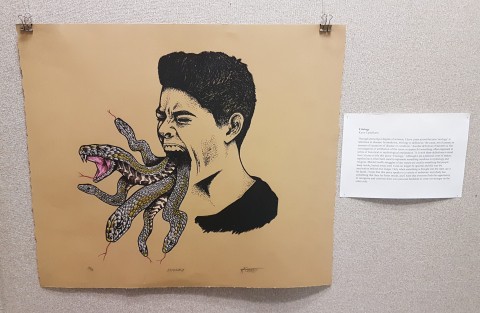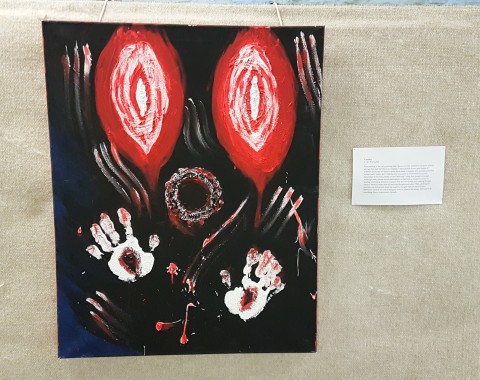The Art in Mind exhibit by Peer Health Usask was a beautiful and striking way to improve mental-health awareness and mental well-being on campus. The display consisted of a multimedia array of artwork, including everything from collage and cartooning to poetry and prose to painting and sculpture.
This year, in honour of Mental-Health Awareness Week, which ran from Oct. 15 to 19, Peer Health co-ordinated an art exhibit in the North Concourse of Place Riel to raise mental-health awareness on campus. The Art in Mind exhibit was displayed from Oct. 22 to 24.
Varied and alluring, this collection of artwork illuminated the wonder of the creative human brain. My personal favourites were the vibrant acrylic paintings and evocative poetic meanderings on the topic of living with mental illness.
Admittedly, I do say that with some bias as an acrylic painter who was herself featured in the show, but bias aside, the depth of emotion, personal nature and sheer vibrancy of the work really impressed me. It takes so much bravery and fortitude of spirit to put this kind of deeply personal art and writing on display for the entire campus to see.

Etiology by Katie Castellarin was display for the Art in Mind exhibit in the North Concourse of Place Riel.
Three of the most striking visual works were Etiology by Katie Castellarin, Self Portrait as a Conduit by Annie Bérubé and Untitled by C.M. Woloschuk. Ranging from supernatural to metaphorical to abstract, each of these works provided an emotive snapshot into the mental world of the artist.
To get an idea of some of the specific things that those of us with mental illness struggle with, one need only read the poems on display. For example, “Untitled” by Heidi Fischer describes a “girl who cries and sleeps too much,” while the speaker in the poem “Anxiety Attack” by Aaron Nepoose explains, “I feel too much. All the time.”
While the written work included in the display was striking, I firmly believe this exhibit was beneficial even to those who did not take the time to read the poetry, as even a cursory glance at the show revealed so much colour and contrast — so much energy and creative fire.
Art in Mind was co-ordinated by Elizabeth Waslen of Peer Health, and for this exhibit, Waslen asked participants to write up a brief explanation of how their artwork related to mental health. Many of the artists on display, myself included, expressed sentiments of art as therapy, art as play, and art as not only creation but also self-exploration and self-healing.

Untitled by C.M. Woloschuk was displayed for the Art in Mind exhibit in the North Concourse of Place Riel.
Art is a vehicle through which we can communicate complicated and difficult emotions that are otherwise difficult to convey.
This makes an art show a uniquely wonderful way to spread awareness of something as deeply personal as mental health. I can’t begin to imagine how many people were touched in some way by the collective efforts of this initiative, but I know it was far more than a scream into the void.
I wrote my first draft of this article sitting across from the exhibit because I wanted to soak up the energy of the artwork. I hoped to imbue some of the beauty and conflict of the work into my writing.
While I observed the exhibit, I witnessed several people stop to experience the artwork — some people stopped and stood as if struck in front of specific visual images, while others paused to consume each line of poetry presented to them.
As an added dimension of the exhibit, Peer Health also displayed a vast array of informational and self-help pamphlets and posters about various topics related to mental illness and mental health.
These informational documents illuminated everything from such basic facets of wellness as sleep, time management and positive self-talk to more challenging topics like substance use and body-focused repetitive behaviours.
To all those who suffer the trials and tribulations of mental illness, know most of all that you are not alone. Whatever your particular concern is, Student Wellness and Peer Health are here to help — and they’ve probably heard it a hundred times before, so don’t let fear hold you back.
For those among us who are struggling with their mental health, keep these four simple tips from Peer Health in mind: (1) take care of your body, (2) connect with others, (3) take breaks throughout the day, and (4) cultivate compassion for yourself and others.
When we talk about mental health, we often focus on mental illness rather than mental wellness. This is why it’s so important to celebrate mental health with something beautiful and creative, like art.
The Art in Mind exhibit communicated to viewers on so many levels that art matters, words matter and mental health matters. To me, it almost seemed like a call to battle: “Hear the call, feel the energy, and go forth to create.”
—
Amanda Slinger / Copy Editor
Photos: Amanda Slinger / Copy Editor